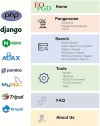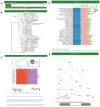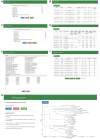FoPGDB: a pangenome database of Fusarium oxysporum, a cross-kingdom fungal pathogen
- PMID: 38537199
- PMCID: PMC10972551
- DOI: 10.1093/database/baae017
FoPGDB: a pangenome database of Fusarium oxysporum, a cross-kingdom fungal pathogen
Abstract
Pangenomes, capturing the genetic diversity of a species or genus, are essential to understanding the ecology, pathobiology and evolutionary mechanisms of fungi that cause infection in crops and humans. However, fungal pangenome databases remain unavailable. Here, we report the first fungal pangenome database, specifically for Fusarium oxysporum species complex (FOSC), a group of cross-kingdom pathogens causing devastating vascular wilt to over 100 plant species and life-threatening fusariosis to immunocompromised humans. The F. oxysporum Pangenome Database (FoPGDB) is a comprehensive resource integrating 35 high-quality FOSC genomes, coupled with robust analytical tools. FoPGDB allows for both gene-based and graph-based exploration of the F. oxysporum pangenome. It also curates a large repository of putative effector sequences, crucial for understanding the mechanisms of FOSC pathogenicity. With an assortment of functionalities including gene search, genomic variant exploration and tools for functional enrichment, FoPGDB provides a platform for in-depth investigations of the genetic diversity and adaptability of F. oxysporum. The modular and user-friendly interface ensures efficient data access and interpretation. FoPGDB promises to be a valuable resource for F. oxysporum research, contributing to our understanding of this pathogen's pangenomic landscape and aiding in the development of novel disease management strategies. Database URL: http://www.fopgdb.site.
© The Author(s) 2024. Published by Oxford University Press.
Conflict of interest statement
There is no conflict of interest.
Figures








References
-
- Ma L.-J., Geiser D.M., Proctor R.H. et al. (2013) Fusarium pathogenomics. Annu. Rev. Microbiol., 67, 399–416. - PubMed
-
- Gordon T.R. (2017) Fusarium oxysporum and the Fusarium Wilt Syndrome. Annu. Rev. Phytopathol., 55, 23–39. - PubMed
-
- Guarro J. (2013) Fusariosis, a complex infection caused by a high diversity of fungal species refractory to treatment. Eur. J. Clin. Microbiol. Infect. Dis., 32, 1491–1500. - PubMed
Publication types
MeSH terms
Supplementary concepts
Grants and funding
LinkOut - more resources
Full Text Sources

